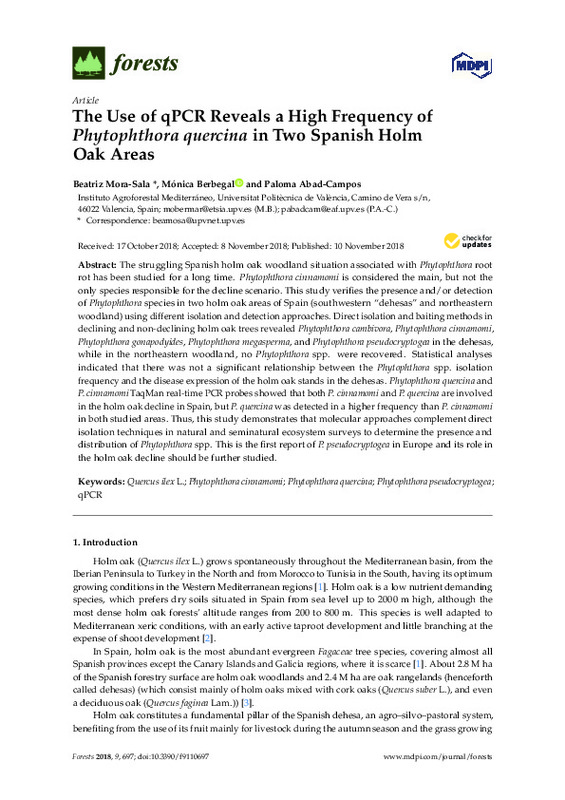JavaScript is disabled for your browser. Some features of this site may not work without it.
Buscar en RiuNet
Listar
Mi cuenta
Estadísticas
Ayuda RiuNet
Admin. UPV
The Use of qPCR Reveals a High Frequency of Phytophthora quercina in Two Spanish Holm Oak Areas
Mostrar el registro sencillo del ítem
Ficheros en el ítem
| dc.contributor.author | Mora-Sala, Beatriz
|
es_ES |
| dc.contributor.author | Berbegal Martinez, Monica
|
es_ES |
| dc.contributor.author | Abad Campos, Paloma
|
es_ES |
| dc.date.accessioned | 2019-06-28T20:04:39Z | |
| dc.date.available | 2019-06-28T20:04:39Z | |
| dc.date.issued | 2018 | es_ES |
| dc.identifier.uri | http://hdl.handle.net/10251/122882 | |
| dc.description.abstract | [EN] The struggling Spanish holm oak woodland situation associated with Phytophthora root rot has been studied for a long time. Phytophthora cinnamomi is considered the main, but not the only species responsible for the decline scenario. This study veri¿es the presence and/or detection of Phytophthora species in two holm oak areas of Spain (southwestern ¿dehesas¿ and northeastern woodland)usingdifferentisolationanddetectionapproaches. Directisolationandbaitingmethodsin declining and non-declining holm oak trees revealed Phytophthoracambivora, Phytophthoracinnamomi, Phytophthoragonapodyides, Phytophthoramegasperma, and Phytophthorapseudocryptogea in the dehesas, while in the northeastern woodland, no Phytophthora spp. were recovered. Statistical analyses indicated that there was not a signi¿cant relationship between the Phytophthora spp. isolation frequencyandthediseaseexpressionoftheholmoakstandsinthedehesas. Phytophthoraquercinaand P.cinnamomiTaqManreal-timePCRprobesshowedthatbothP.cinnamomiandP.quercinaareinvolved in the holm oak decline in Spain, but P. quercina was detected in a higher frequency than P. cinnamomi in both studied areas. Thus, this study demonstrates that molecular approaches complement direct isolation techniques in natural and seminatural ecosystem surveys to determine the presence and distribution of Phytophthora spp. This is the ¿rst report of P. pseudocryptogea in Europe and its role in the holm oak decline should be further studied. | es_ES |
| dc.description.sponsorship | This research was supported by funding from the project AGL2011-30438-C02-01 (Ministerio de Economia y Competitividad, Spain). | es_ES |
| dc.language | Inglés | es_ES |
| dc.publisher | MDPI AG | es_ES |
| dc.relation.ispartof | Forests | es_ES |
| dc.rights | Reconocimiento (by) | es_ES |
| dc.subject | Quercus ilex L | es_ES |
| dc.subject | Phytophthora cinnamomi | es_ES |
| dc.subject | Phytophthora quercina | es_ES |
| dc.subject | Phytophthora pseudocryptogea | es_ES |
| dc.subject | QPCR | es_ES |
| dc.subject.classification | PRODUCCION VEGETAL | es_ES |
| dc.subject.classification | BOTANICA | es_ES |
| dc.title | The Use of qPCR Reveals a High Frequency of Phytophthora quercina in Two Spanish Holm Oak Areas | es_ES |
| dc.type | Artículo | es_ES |
| dc.identifier.doi | 10.3390/f9110697 | es_ES |
| dc.relation.projectID | info:eu-repo/grantAgreement/MICINN//AGL2011-30438-C02-01/ES/APLICACION DE TECNICAS MOLECULARES PARA VALORAR LA IMPLICACION DE PHYTOPHTHORA SPP. EN EL DECAIMIENTO DE QUERCUS ILEX/ | |
| dc.rights.accessRights | Abierto | es_ES |
| dc.contributor.affiliation | Universitat Politècnica de València. Instituto Agroforestal Mediterráneo - Institut Agroforestal Mediterrani | es_ES |
| dc.contributor.affiliation | Universitat Politècnica de València. Departamento de Ecosistemas Agroforestales - Departament d'Ecosistemes Agroforestals | es_ES |
| dc.description.bibliographicCitation | Mora-Sala, B.; Berbegal Martinez, M.; Abad Campos, P. (2018). The Use of qPCR Reveals a High Frequency of Phytophthora quercina in Two Spanish Holm Oak Areas. Forests. 9(11):1-14. https://doi.org/10.3390/f9110697 | es_ES |
| dc.description.accrualMethod | S | es_ES |
| dc.relation.publisherversion | https://doi.org/10.3390/f9110697 | es_ES |
| dc.description.upvformatpinicio | 1 | es_ES |
| dc.description.upvformatpfin | 14 | es_ES |
| dc.type.version | info:eu-repo/semantics/publishedVersion | es_ES |
| dc.description.volume | 9 | es_ES |
| dc.description.issue | 11 | es_ES |
| dc.identifier.eissn | 1999-4907 | es_ES |
| dc.relation.pasarela | S\375473 | es_ES |
| dc.contributor.funder | Ministerio de Ciencia e Innovación |








